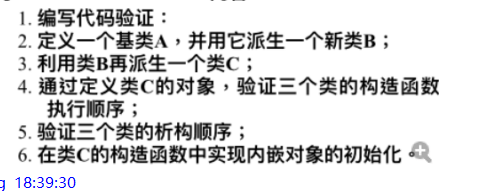一、

代码:

1 #include<stdio.h> 2 #include<string.h> 3 #include<algorithm> 4 #include<iostream> 5 using namespace std; 6 class A 7 { 8 public: 9 int a,b; 10 A(); 11 A(int x,int y); 12 ~A(); 13 }; 14 A::A() 15 { 16 printf("调用A类构造函数 "); 17 } 18 A::A(int x,int y) 19 { 20 a=x; 21 b=y; 22 printf("调用A类构造函数 "); 23 } 24 A::~A() 25 { 26 printf("调用A类析构函数 "); 27 } 28 class B:public A 29 { 30 public: 31 int aa,bb; 32 B() 33 { 34 printf("调用B类构造函数 "); 35 } 36 B(int x,int y) 37 { 38 aa=x; 39 bb=y; 40 printf("调用B类构造函数 "); 41 } 42 ~B() 43 { 44 printf("调用B类析构函数 "); 45 } 46 }; 47 class C:public B 48 { 49 public: 50 int aaa,bbb; 51 B one; 52 C(int x,int y) 53 { 54 aaa=x; 55 bbb=y; 56 one.aa=x; 57 one.bb=y; 58 printf("调用C类构造函数 "); 59 } 60 ~C() 61 { 62 printf("调用C类析构函数 "); 63 } 64 }; 65 int main() 66 { 67 C first(0,0); 68 printf("%d %d %d %d ",first.aaa,first.bbb,first.one.aa,first.one.bb); 69 return 0; 70 }
二、


1 #include<stdio.h> 2 #include<string.h> 3 #include<algorithm> 4 #include<iostream> 5 using namespace std; 6 class Base 7 { 8 public: 9 Base(int x,int y) 10 { 11 a=x; 12 b=y; 13 } 14 virtual void show() //声明了虚函数,那么指针指向哪个对象就用那个对象的函数 15 { //否则的话,声明指针是什么类型就会用那个类型的函数 16 cout<<"基类内容show打印"<<endl; 17 cout<<"a:"<<a<<"b:"<<b<<endl; 18 } 19 void prinf() 20 { 21 cout<<"基类内容prinf打印"<<endl; 22 cout<<"a:"<<a<<"b:"<<b<<endl; 23 } 24 private: 25 int a,b; 26 27 }; 28 class One:public Base 29 { 30 public: 31 32 One(int x,int y):Base(x,y) 33 { 34 aa=x; 35 bb=y; 36 } 37 void show() 38 { 39 cout<<"派生类内容show打印"<<endl; 40 cout<<"aa:"<<aa<<"bb:"<<bb<<endl; 41 } 42 void prinf() 43 { 44 cout<<"派生类内容prinf打印"<<endl; 45 cout<<"aa:"<<aa<<"bb:"<<bb<<endl; 46 } 47 private: 48 int aa,bb; 49 }; 50 int main() 51 { 52 Base mb(100,200),*pc; 53 One mc(200,300); 54 pc=&mc; 55 pc->show(); 56 pc->prinf(); 57 pc=&mb; 58 pc->show(); 59 pc->prinf(); 60 return 0; 61 } 62 63 //2、 64 #include<stdio.h> 65 #include<string.h> 66 #include<algorithm> 67 #include<iostream> 68 using namespace std; 69 class Shape //抽象类定义是只要里面有一个纯虚函数那他就是抽象类, 70 { //抽象类不需要什么关键字来定义,且它的派生类必须覆盖重写他的纯虚方法 71 public : 72 double a; 73 Shape(double x) 74 { 75 a=x; 76 } 77 virtual void area()=0; 78 virtual void show()=0; 79 }; 80 class Circle:public Shape 81 { 82 public: 83 Circle(double x):Shape(x) 84 { 85 86 } 87 void area() 88 { 89 cout<<"the circle area is :"<<endl; 90 cout<<3.14*a*a<<endl; 91 } 92 void show() 93 { 94 cout<<"a:"<<a<<endl; 95 } 96 }; 97 int main() 98 { 99 Shape *ptr; 100 Circle r(6); 101 ptr=&r; 102 ptr->area(); 103 ptr->show(); 104 return 0; 105 } 106 107 //3、 108 #include<stdio.h> 109 #include<string.h> 110 #include<algorithm> 111 #include<iostream> 112 #include<typeinfo> 113 using namespace std; 114 class Sqare 115 { 116 public : 117 double a; 118 Sqare(double x) 119 { 120 a=x; 121 } 122 }; 123 class Circle 124 { 125 public : 126 double a; 127 Circle(double x) 128 { 129 a=x; 130 } 131 }; 132 int main() 133 { 134 Sqare one(1); 135 Circle two(2); 136 if(typeid(one)==typeid(Sqare)) //判断对象类型 137 { 138 cout<<"它是Sqare对象"<<endl; 139 } 140 else 141 { 142 cout<<"它是Circle对象"<<endl; 143 } 144 145 if(typeid(two)==typeid(Sqare)) 146 { 147 cout<<"它是Sqare对象"<<endl; 148 } 149 else 150 { 151 cout<<"它是Circle对象"<<endl; 152 } 153 return 0; 154 }
